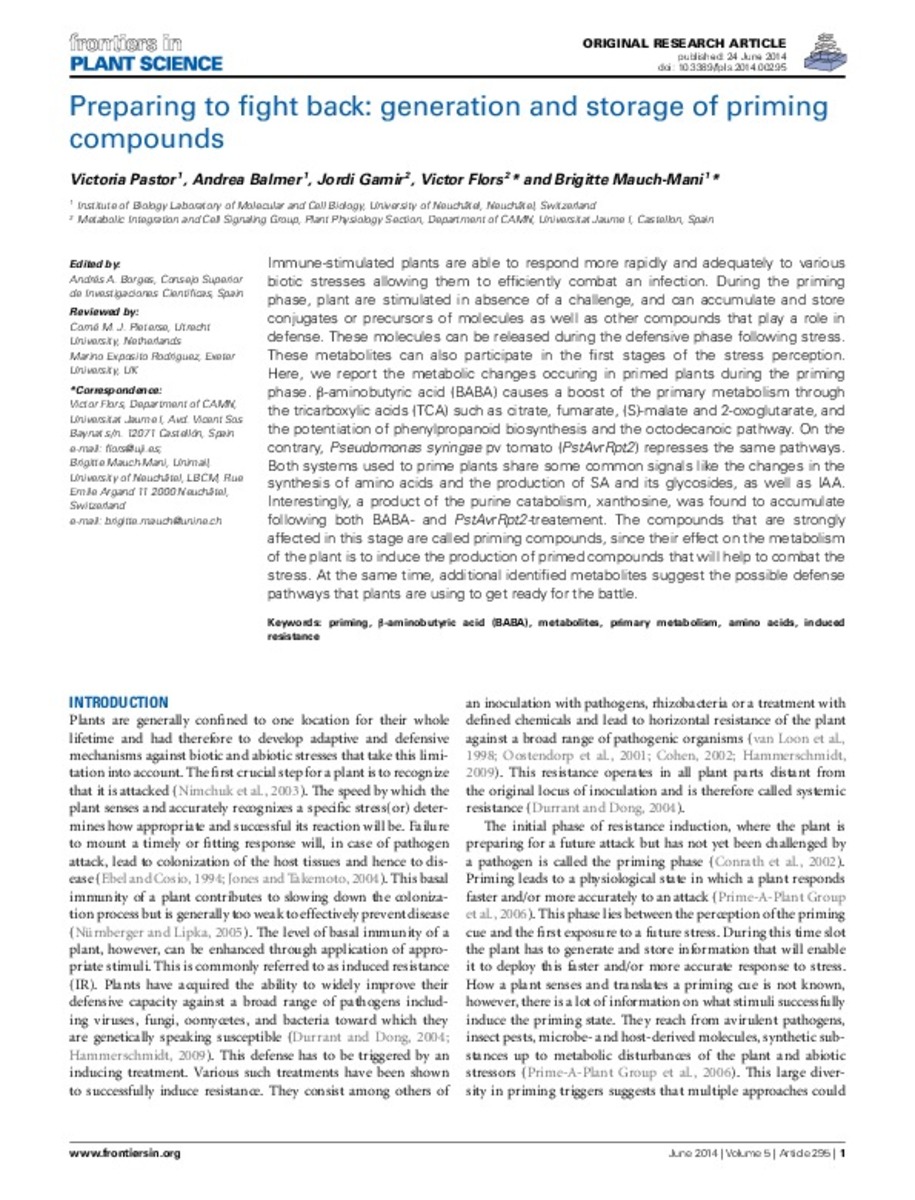Mostrar el registro sencillo del ítem
Preparing to fight back: generation and storage of priming compounds
| dc.contributor.author | Pastor, Victoria | |
| dc.contributor.author | Balmer, Andrea | |
| dc.contributor.author | Gamir, Jordi | |
| dc.contributor.author | Flors, Victor | |
| dc.contributor.author | Mauch-Mani, Brigitte | |
| dc.date.accessioned | 2015-07-16T11:47:06Z | |
| dc.date.available | 2015-07-16T11:47:06Z | |
| dc.date.issued | 2014 | |
| dc.identifier.issn | 1664-462X | |
| dc.identifier.uri | http://hdl.handle.net/10234/127849 | |
| dc.description.abstract | Immune-stimulated plants are able to respond more rapidly and adequately to various biotic stresses allowing them to efficiently combat an infection. During the priming phase, plant are stimulated in absence of a challenge, and can accumulate and store conjugates or precursors of molecules as well as other compounds that play a role in defense. These molecules can be released during the defensive phase following stress. These metabolites can also participate in the first stages of the stress perception. Here, we report the metabolic changes occuring in primed plants during the priming phase. β-aminobutyric acid (BABA) causes a boost of the primary metabolism through the tricarboxylic acids (TCA) such as citrate, fumarate, (S)-malate and 2-oxoglutarate, and the potentiation of phenylpropanoid biosynthesis and the octodecanoic pathway. On the contrary, Pseudomonas syringae pv tomato (PstAvrRpt2) represses the same pathways. Both systems used to prime plants share some common signals like the changes in the synthesis of amino acids and the production of SA and its glycosides, as well as IAA. Interestingly, a product of the purine catabolism, xanthosine, was found to accumulate following both BABA- and PstAvrRpt2-treatement. The compounds that are strongly affected in this stage are called priming compounds, since their effect on the metabolism of the plant is to induce the production of primed compounds that will help to combat the stress. At the same time, additional identified metabolites suggest the possible defense pathways that plants are using to get ready for the battle. | ca_CA |
| dc.format.mimetype | application/pdf | ca_CA |
| dc.language.iso | eng | ca_CA |
| dc.publisher | Frontiers | ca_CA |
| dc.relation.isPartOf | Frontiers in plant science, 2014, vol. 5 | ca_CA |
| dc.rights | Attribution 4.0 Spain | * |
| dc.rights | This Document is Protected by copyright and was first published by Frontiers. All rights reserved. it is reproduced with permission. Copyright © 2014 Pastor, Balmer, Gamir, Flors and Mauch-Mani. This is an open-access article distributed under the terms of the Creative Commons Attribution License (CC BY). The use, distribution or reproduction in other forums is permitted, provided the original author(s) or licensor are credited and that the original publication in this journal is cited, in accordance with accepted academic practice. No use, distribution or reproduction is permitted which does not comply with these terms. | |
| dc.rights.uri | http://creativecommons.org/licenses/by-sa/4.0/ | * |
| dc.subject | priming | ca_CA |
| dc.subject | β-aminobutyric acid (BABA) | ca_CA |
| dc.subject | metabolites | ca_CA |
| dc.subject | primary metabolism | ca_CA |
| dc.subject | amino acids | ca_CA |
| dc.subject | induced resistance | ca_CA |
| dc.title | Preparing to fight back: generation and storage of priming compounds | ca_CA |
| dc.type | info:eu-repo/semantics/article | ca_CA |
| dc.identifier.doi | http://dx.doi.org/10.3389/fpls.2014.00295 | |
| dc.rights.accessRights | info:eu-repo/semantics/openAccess | ca_CA |
| dc.relation.publisherVersion | http://journal.frontiersin.org/article/10.3389/fpls.2014.00295/abstract | ca_CA |
Ficheros en el ítem
Este ítem aparece en la(s) siguiente(s) colección(ones)
-
CAMN_Articles [566]








